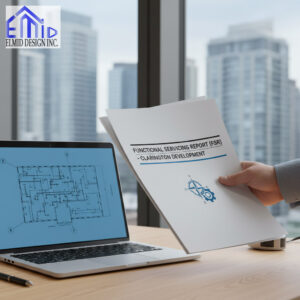A Functional Servicing Report Ontario is an essential document in land development, providing municipalities with technical evidence that a proposed site can be adequately serviced by existing or planned municipal infrastructure. It bridges planning and engineering by showing how water, wastewater, and storm systems will operate under future conditions. Without this report, development applications cannot move forward because it proves the technical feasibility and sustainability of the project. Understanding how to prepare a compliant Functional Servicing Report in Ontario is critical for developers, engineers, and planners seeking municipal approvals.
Key Takeaways
A Functional Servicing Report Ontario evaluates how a development connects to and impacts municipal servicing networks. It ensures that infrastructure is safe, efficient, and environmentally sound. It must be prepared by a licensed professional engineer under the authority of the Professional Engineers of Ontario. The report considers water supply, wastewater, stormwater, and grading systems, aligning with municipal design standards and policies. Elmid Design Inc, an engineering company authorized by PEO, specializes in producing Functional Servicing Reports that meet municipal expectations and technical accuracy.
What is a Functional Servicing Report in Ontario
A Functional Servicing Report Ontario outlines the technical servicing framework for a proposed development. It determines whether municipal water, sanitary, and storm systems can support the project without negative impacts. The report is not a construction plan but rather a planning-level document that informs decision-making before detailed design begins. Municipalities rely on it to confirm system capacity and to assess if upgrades or offsite improvements are needed. Preparing a thorough report requires professional engineering expertise and coordination with municipal staff to ensure compliance with local standards and provincial regulations.
Regulatory and Policy Framework in Ontario for FSRs
The preparation of a Functional Servicing Report Ontario follows several key regulations and policies. The Ontario Planning Act mandates that developments demonstrate adequate servicing. The Provincial Policy Statement emphasizes sustainable infrastructure and environmental protection. Each municipality adds its own standards through official plans and engineering guidelines, ensuring alignment with regional master servicing strategies. Conservation authorities may also review the report when developments affect floodplains or natural systems. Reports must be certified by a licensed engineer in accordance with the Professional Engineers of Ontario Act, which establishes the technical and ethical standards for engineering practice.
When is a Functional Servicing Report Required in Ontario
A Functional Servicing Report Ontario is required at various stages of the planning and development process. It is commonly needed for draft plan of subdivision, zoning by-law amendment, or site plan applications where new or intensified land use may affect servicing networks. Municipalities request an FSR when development may increase demand on water, wastewater, or storm systems beyond existing capacities. Smaller projects within established areas might require a servicing brief instead, depending on municipal policy. Early consultation with planning and engineering departments ensures that the report scope aligns with submission requirements, avoiding costly delays.
Key Components of a Functional Servicing Report
A Functional Servicing Report Ontario follows a consistent structure to provide transparency and clarity for reviewers. It begins with an introduction that outlines project background and objectives. The next section describes existing site conditions, including topography, infrastructure, and environmental features. The core of the report focuses on proposed servicing strategies for water, wastewater, and stormwater systems. Supporting sections include hydraulic modeling results, assumptions, and design criteria. Appendices typically include drawings, flow calculations, and correspondence with municipal departments. The report must demonstrate compliance with all applicable engineering standards and clearly outline any required system upgrades.
Water Supply and Distribution in FSRs
The water servicing section of a Functional Servicing Report Ontario confirms that sufficient supply and pressure exist to serve the proposed development. Engineers calculate water demand using average day, maximum day, and peak hour flow rates. They verify hydrant flow results, pressure zones, and looping to maintain reliable distribution. The report identifies connection points, pipe sizes, and any required upgrades to municipal mains. Fire flow requirements are checked against available capacity to ensure safety. Elmid Design Inc uses hydraulic modeling tools to simulate flow conditions and verify that the proposed network meets both municipal standards and fire protection requirements.
Sanitary and Wastewater Servicing in FSRs
Sanitary servicing is a critical component of a Functional Servicing Report Ontario. The report assesses how wastewater generated by the proposed development will be conveyed to the municipal system without exceeding downstream capacity. Engineers estimate peak flow using population and land-use data, applying accepted peaking factors. The report outlines pipe routing, slopes, and manhole locations. If pumping stations are necessary, their design intent and operational parameters are summarized. Capacity checks against existing sanitary infrastructure help determine if upgrades are required. Municipalities often request that these analyses align with current master servicing plans to maintain system integrity.

Stormwater Drainage and Management in FSRs
A Functional Servicing Report Ontario must include a detailed assessment of stormwater drainage and management to prevent flooding and protect water quality. Engineers compare pre-development and post-development runoff conditions using hydrologic modeling to ensure that post-development flows do not exceed existing rates. The report outlines stormwater storage and treatment solutions that comply with municipal and provincial standards. Low Impact Development methods such as infiltration trenches or permeable surfaces are often incorporated to promote sustainability. Each design element must support long-term performance and minimize downstream impacts. Elmid Design Inc prepares stormwater analyses that align with current Ontario guidelines while ensuring projects remain efficient and environmentally responsible.
Grading, Drainage, and Overland Flow Routes
Proper grading and overland drainage are essential parts of a Functional Servicing Report Ontario. Grading plans ensure that surface runoff is directed safely toward designated catch basins or storm sewers without affecting neighboring properties. The report identifies overland flow routes that handle major storm events when underground systems reach capacity. These routes prevent property damage by guiding water along safe pathways. Municipal standards typically require that grading integrates with existing topography and that slopes are designed to minimize erosion. A well-prepared grading and drainage strategy supports stormwater performance and maintains the overall stability of the site.
Impacts, Mitigation, and Off-site Works
A Functional Servicing Report Ontario must evaluate potential impacts of development on municipal infrastructure and propose mitigation measures. If existing systems lack capacity, the report recommends upgrades or off-site works such as sewer extensions, watermain looping, or storm sewer expansion. These improvements may be coordinated with municipal capital plans to optimize timing and cost. The report must also identify environmental impacts like altered drainage patterns or erosion risks and outline strategies to reduce them. Mitigation plans may include phased implementation or flow control measures to ensure infrastructure continues to perform effectively as development progresses.
Phasing, Staging, and Interim Servicing
Large developments in Ontario often proceed in stages, requiring clear phasing strategies in the Functional Servicing Report Ontario. Each phase must demonstrate adequate servicing capacity before approval. Interim servicing may be needed when full municipal connections are unavailable. Engineers outline temporary systems that meet municipal standards without compromising long-term function. Phasing plans also help coordinate with nearby projects or planned infrastructure upgrades. Municipalities rely on these details to manage growth in an orderly and sustainable manner. Elmid Design Inc ensures that phasing and interim servicing align with municipal priorities and long-term servicing objectives.
Report Format, Drawings, Appendices, and Submission
The structure of a Functional Servicing Report Ontario follows standardized municipal expectations. Reports begin with a summary of purpose and methodology, followed by detailed analyses for water, wastewater, and storm systems. Engineering drawings illustrate proposed infrastructure, grading, and servicing connections. Appendices include calculations, modeling results, and correspondence with municipal departments. The report must be sealed and signed by a licensed professional engineer to meet the Professional Engineers of Ontario requirements. Submission occurs through the municipal planning process and may involve coordination with multiple agencies. Clear, complete documentation accelerates review and minimizes revisions.
Review, Peer Review, and Municipal Comments
Once submitted, a Functional Servicing Report Ontario undergoes municipal review to confirm compliance with local standards. Municipal engineers assess system capacity, design assumptions, and integration with existing networks. For complex projects, an independent peer review may be required. The peer reviewer examines technical accuracy and verifies that modeling and assumptions are reasonable. Applicants respond to comments by providing revised drawings or additional analysis. The process ensures that servicing solutions are safe, efficient, and environmentally sustainable. Elmid Design Inc coordinates closely with municipal reviewers to achieve timely approvals and technically sound outcomes.
Common Challenges and Best Practices
Preparing a Functional Servicing Report Ontario involves several challenges that require careful management. Common issues include limited data on existing infrastructure, conflicting utility information, and evolving municipal standards. Early consultation with municipal staff helps clarify requirements and prevents rework. Using current GIS data, verified flow tests, and calibrated models improves report accuracy. Best practices also include consistent documentation and clear communication among design teams. Reports prepared by certified professionals demonstrate credibility and technical integrity. Elmid Design Inc applies these practices to deliver reports that meet both regulatory standards and client expectations.
Advanced Stormwater Modeling in Functional Servicing Reports
An advanced Functional Servicing Report Ontario often includes detailed stormwater modeling to predict system performance under various rainfall scenarios. Engineers use modeling software such as SWMM or PCSWMM to simulate flow rates, runoff volumes, and storage capacity. These simulations verify that post-development flows remain within acceptable limits and that drainage systems can manage extreme weather events. Modeling also helps optimize pond sizing, outlet structures, and infiltration systems. Municipalities in Ontario rely on these results to confirm that stormwater infrastructure will function effectively over the long term. Elmid Design Inc applies advanced modeling tools to ensure each report meets both technical and environmental expectations.
Low Impact Development Techniques in Ontario FSRs
Low Impact Development, or LID, is a key feature of a modern Functional Servicing Report Ontario. It focuses on controlling runoff close to the source through infiltration, filtration, and evaporation. Techniques include bioretention areas, rain gardens, permeable pavements, and green roofs. These systems improve water quality and reduce demand on municipal storm sewers. Incorporating LID measures aligns with the Ministry of Environment, Conservation and Parks’ emphasis on sustainable stormwater management. Properly designed LID features also enhance groundwater recharge and protect nearby natural systems. Elmid Design Inc integrates LID strategies in its FSRs to create environmentally resilient developments across Ontario.
Integrating Environmental Considerations in FSRs
Environmental assessment is an important aspect of every Functional Servicing Report Ontario. The report must evaluate how proposed infrastructure could affect natural features such as wetlands, rivers, or woodlands. Engineers assess erosion potential, groundwater impacts, and habitat disturbance. Where sensitive features exist, mitigation strategies are recommended to maintain ecological balance. Conservation authorities often review this section to ensure compliance with watershed management policies. Including environmental integration strengthens the technical and regulatory credibility of the report. A properly balanced FSR supports both urban development and environmental preservation, reflecting the principles of sustainable engineering practice.
Case Studies of Functional Servicing Reports in Ontario
Several case studies across Ontario demonstrate how Functional Servicing Reports support successful development. In urban infill projects, reports ensure that older infrastructure can handle new demands without compromising service quality. In suburban subdivisions, detailed FSRs define clear servicing strategies that phase in municipal growth. Industrial projects often rely on custom solutions for high water demand or unique drainage conditions. Each example highlights the importance of technical accuracy, professional engineering oversight, and early municipal engagement. Elmid Design Inc has completed numerous FSRs that have contributed to efficient approvals and sustainable community design within Ontario’s growing municipalities.
Coordination Between Developers and Municipalities
Effective coordination between developers and municipalities is a cornerstone of every Functional Servicing Report Ontario. Early pre-consultation meetings define the report’s scope and identify data needs. Municipal engineers provide feedback on available capacity, system constraints, and future infrastructure plans. Developers, in turn, adjust their design concepts to meet municipal expectations. This collaboration reduces review timelines and promotes mutual understanding of servicing objectives. Elmid Design Inc promotes strong communication between all parties to streamline the approval process and ensure compliance with municipal policies. Coordinated planning leads to more efficient and cost-effective project outcomes.
The Role of Professional Engineers in FSR Preparation
A Functional Servicing Report Ontario must be prepared and certified by a licensed professional engineer. The engineer’s responsibility includes ensuring technical accuracy, regulatory compliance, and public safety. Professional Engineers Ontario regulates this practice under its Code of Ethics and licensing framework. Engineers provide not only technical expertise but also accountability to the public interest. They must maintain transparency in data sources, modeling assumptions, and design recommendations. Elmid Design Inc, holding a Certificate of Authorization from the Professional Engineers of Ontario, upholds these professional standards in every report, ensuring both technical integrity and public confidence.
Importance of Data Collection and Field Investigation
Accurate data collection forms the foundation of a reliable Functional Servicing Report Ontario. Field investigations include topographic surveys, utility locates, flow monitoring, and hydrant flow testing. These data help engineers verify the condition and capacity of existing municipal systems. Without this information, analysis results may be incomplete or misleading. Reliable field data support confident design decisions and credible conclusions. Elmid Design Inc conducts thorough investigations before analysis to ensure every recommendation is based on verified site conditions and real performance data. This level of diligence enhances both report quality and municipal trust.
Future Trends in Functional Servicing Reports
The future of Functional Servicing Report Ontario is evolving with new technologies and sustainability expectations. Digital modeling tools now integrate climate change scenarios to predict long-term system resilience. Data-sharing platforms between municipalities and consultants improve review efficiency and transparency. Green infrastructure and water reuse are becoming central to modern servicing design. Municipalities are increasingly requiring reports to address carbon reduction and lifecycle impacts. Elmid Design Inc continues to adapt to these changes, combining innovation with regulatory compliance to deliver forward-looking engineering solutions that align with Ontario’s environmental and growth objectives.
Role of Functional Servicing Reports in Urban Planning
A Functional Servicing Report Ontario supports sustainable urban planning by linking engineering feasibility with land use decisions. It ensures that every development proposal aligns with existing municipal systems and capacity limits. Municipal planners rely on these reports to evaluate whether water, wastewater, and stormwater systems can support future growth. The report also helps balance environmental protection with infrastructure efficiency. By integrating servicing data into planning decisions, municipalities can manage density and land use more effectively. Elmid Design Inc works closely with planning departments to align technical servicing solutions with long-term municipal growth objectives.
Integration of Climate Resilience in FSRs
Modern Functional Servicing Reports Ontario incorporate climate resilience to address increasing rainfall intensity and unpredictable weather. Engineers analyze system performance under future climate conditions to ensure that drainage infrastructure can withstand extreme storms. Resilient design includes larger storm sewers, enhanced storage capacity, and green infrastructure that manages runoff naturally. Incorporating climate resilience reduces maintenance costs and protects communities from flooding. Municipalities across Ontario now require this analysis as part of every report submission. Elmid Design Inc integrates climate adaptation strategies into its servicing reports to promote infrastructure durability and long-term community safety.
Technological Innovations in Functional Servicing Reports
Technology continues to transform the preparation of Functional Servicing Report Ontario. Advanced modeling software, geographic information systems, and data visualization tools have improved the precision of analysis and presentation. Digital twin technologies allow engineers to simulate how municipal systems behave under various development conditions. This approach enhances design reliability and decision-making. Cloud-based collaboration also enables faster municipal review and version control. Elmid Design Inc employs modern engineering technologies that meet Ontario’s data accuracy standards and accelerate the approval process. These innovations ensure that every report remains both comprehensive and efficient for clients and regulators.
Municipal Review and Approval Coordination
Coordination during the municipal review process is vital to achieving timely approvals for a Functional Servicing Report Ontario. Engineers and developers must address all technical comments and revise reports accordingly. Continuous communication between consultants and municipal staff helps prevent misinterpretations and unnecessary delays. Understanding local submission protocols and design standards ensures smoother processing. Municipal reviewers evaluate system capacity, serviceability, and environmental compliance before granting approval. Elmid Design Inc prioritizes clear coordination with municipal reviewers to maintain technical accuracy, regulatory alignment, and project momentum throughout the approval process.
Legal and Regulatory Responsibilities of FSR Authors
Engineers preparing a Functional Servicing Report Ontario carry legal and ethical responsibilities under provincial regulations. Each report must comply with the Professional Engineers Act and be sealed by a licensed engineer authorized by the Professional Engineers of Ontario. This certification ensures that the analysis meets technical standards and that the engineer accepts professional accountability for their work. The report also must adhere to municipal bylaws, conservation authority regulations, and provincial environmental policies. Elmid Design Inc upholds all professional obligations, maintaining transparency, integrity, and compliance in every submission to protect public safety and trust.
Cost Efficiency and Value of Comprehensive FSRs
A well-prepared Functional Servicing Report Ontario provides significant financial benefits for developers and municipalities. Early identification of infrastructure constraints reduces redesign costs and avoids unexpected capital expenditures. Accurate modeling and data-driven recommendations help prevent delays in approvals, which can otherwise increase project budgets. Municipalities benefit from reduced maintenance and improved service reliability when servicing is properly planned. Elmid Design Inc focuses on delivering technically sound and cost-efficient solutions that provide long-term value for clients while supporting municipal infrastructure sustainability. A detailed and credible FSR becomes an investment in smoother project execution.
Collaboration with Conservation Authorities
Collaboration with conservation authorities strengthens the environmental integrity of a Functional Servicing Report Ontario. Conservation authorities review FSRs for impacts on floodplains, wetlands, and natural heritage features. They assess stormwater quality, erosion potential, and water balance compliance with watershed management objectives. Early engagement with these agencies helps resolve issues before formal submission. This approach accelerates approvals and ensures regulatory compliance. Elmid Design Inc consistently works with conservation authorities to integrate their feedback into design solutions, creating reports that meet environmental and municipal expectations simultaneously. Effective collaboration promotes balanced development across Ontario’s regulated watersheds.
Quality Assurance in Functional Servicing Reports
Quality assurance ensures that every Functional Servicing Report Ontario meets both technical and professional standards. Therefore, review procedures carefully include verifying data accuracy, cross-checking design calculations, and validating hydraulic models. Moreover, internal quality control minimizes potential errors that could otherwise delay municipal review or compromise project approval. In addition, consistency across drawings, text, and appendices improves clarity for municipal reviewers. Furthermore, municipalities frequently require that reports follow their terms of reference to maintain transparency and accountability. Consequently, Elmid Design Inc applies strict quality assurance protocols on every project to guarantee that each report demonstrates reliability, professionalism, and full compliance with Ontario’s engineering standards.
Importance of Public Infrastructure Coordination
Functional Servicing Report Ontario plays an essential role in coordinating new developments with existing public infrastructure. Reports identify connection points, service capacities, and potential upgrades required to support growth. They also highlight how proposed projects integrate with nearby municipal improvements or capital works. Coordinating this information ensures that development complements rather than burdens municipal systems. It also allows municipalities to plan future upgrades strategically. Elmid Design Inc collaborates with public works departments to align each report with infrastructure priorities, promoting efficient growth and sustainable community development across Ontario.
FAQs
What is the difference between a Functional Servicing Report and a Detailed Design?
A Functional Servicing Report Ontario provides a conceptual-level analysis of how a site will connect to municipal systems, while a detailed design includes construction-ready plans and specifications.
Can a developer submit a development application without a Functional Servicing Report?
Most municipalities require a Functional Servicing Report Ontario before accepting development applications because it confirms that municipal infrastructure can support the proposed project.
How long does it take to prepare a Functional Servicing Report?
The time depends on project size and data availability, but typically ranges from two to six weeks once background information and survey data are available.
Who must prepare the Functional Servicing Report in Ontario?
Only a licensed professional engineer registered with the Professional Engineers of Ontario can prepare and certify a Functional Servicing Report Ontario.
What happens if municipal servicing capacity is insufficient?
If capacity is limited, the report recommends infrastructure upgrades or phasing strategies to align with municipal capital plans before development can proceed.

Elmid Design Inc: Trusted Engineering Experts in Ontario
Elmid Design Inc is a professional engineering firm in Ontario with a Certificate of Authorization from the Professional Engineers of Ontario. The company specializes in preparing Functional Servicing Reports, stormwater management designs, grading plans, and municipal infrastructure assessments. With a focus on technical accuracy, regulatory compliance, and sustainable engineering solutions, Elmid Design Inc helps developers and municipalities achieve efficient and timely project approvals. Its commitment to quality, transparency, and client satisfaction has positioned the firm as a trusted leader in civil and municipal engineering across Ontario.
Geographic Locations That We Service:
Our Licensed Professional Engineers specializing in Engineered Site Grading Plans offer the best-engineered site grading plan, lot grading and erosion plan, and drainage plan to obtain site plan approval and building permits in Ontario, including a wide range of municipalities. Each area boasts unique features and requirements, making our tailored approach essential for success.
Toronto and Surrounding Areas
In the vibrant heart of Ontario, we service Toronto (City of Toronto) and surrounding areas. Additionally, we cover Oshawa (City of Oshawa), Pickering (City of Pickering), and Clarington (Municipality of Clarington). Furthermore, our expertise extends to Ajax (Town of Ajax), Whitby (Town of Whitby), Brock (Township of Brock), Scugog (Township of Scugog), and Uxbridge (Township of Uxbridge).
Halton Region
Moving to the Halton Region, our services encompass Burlington (City of Burlington) and Halton Hills (Town of Halton Hills). Also included are Milton (Town of Milton) and Oakville (Town of Oakville).
Peel Region
In the Peel Region, we provide services in Brampton (City of Brampton), Mississauga (City of Mississauga), and Caledon (Town of Caledon).
York Region
Our services in the York Region cover Vaughan (City of Vaughan), Aurora (Town of Aurora), and East Gwillimbury (Town of East Gwillimbury). We also cater to Georgina (Town of Georgina), Markham (City of Markham), Newmarket (Town of Newmarket), Richmond Hill (City of Richmond Hill), Whitchurch-Stouffville (Town of Whitchurch-Stouffville), King (Township of King), and Bradford-West Gwillimbury (Town of Bradford-West Gwillimbury). Each municipality here offers a distinct setting, requiring our specialized approach.
Other Southern Ontario Cities and Towns
We also serve many other cities and towns in Southern Ontario. These include Hamilton (City of Hamilton), St. Catharines (City of St. Catharines), Niagara on the Lake (Town of Niagara on the Lake), Brant (County of Brant), Cambridge (City of Cambridge), Kitchener (City of Kitchener), Waterloo (City of Waterloo), and Woodstock (City of Woodstock). Furthermore, we operate in Guelph (City of Guelph), Centre Wellington (Township of Centre Wellington), Shelburne (Town of Shelburne), Orangeville (Town of Orangeville), New Tecumseth (Town of New Tecumseth), Essa (Town of Essa), Collingwood (Town of Collingwood), Wasaga Beach (Town of Wasaga Beach), Barrie (City of Barrie), Midland (Town of Midland), Orillia (City of Orillia), Ramara (Town of Ramara), Minden Hills (Town of Minden Hills), North Kawartha (Town of North Kawartha), Kawartha Lakes (City of Kawartha Lakes), Peterborough (City of Peterborough), Selwyn (Town of Selwyn), and Brighton (Municipality of Brighton).




